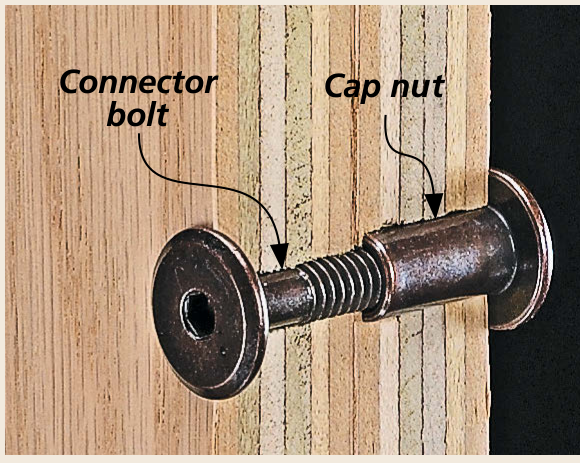
Most projects are assembled once and, with luck, forever. But sometimes, this isn’t the most practical way to put a project together. With the lifestyle that many people live today, a project can often do a lot of traveling — from room to room, floor to floor, or even from home to home. So sometimes it makes sense to take this mobility into account by incorporating knock-down (KD) hardware into the design.
Today, there’s a wide range of knockdown fasteners available — from simple to sophisticated — that give you lots of quick, easy building and assembly options. Here’s a look at a good sampling.
1 Blum KD Fittings
One of the best options I’ve found for knock-down case construction is the Blum KD Fittings shown in the photos at left. The installation is very straightforward, they have excellent holding power and, as you see at left, the installed fitting hardly shows.

The two-part fitting consists of a 1"-dia. plastic, press-in housing and a connector screw. The housing is inserted into a hole drilled in the support panel while the connector screw is set into the end of the intersecting panel (inset photo, left). When you turn the locking screw on the surface of the housing, an internal metal cam engages the head of the connector screw, pulling the two pieces snugly together.
2 Surface-Mount Connectors
When appearance or possible obstruction is not quite as important, the surface-mount panel connectors shown at right might be the ticket. The big advantage to using this fastener is that the installation requires nothing more complicated than drilling pilot holes for the mounting screws.

The locking plate is positioned and screwed to one panel. The housing is installed on the second panel to fit over it. A screw on the housing turns an internal cam that locks the two panels tightly in place.
3 Metal Biscuit Fasteners
Metal biscuit fasteners offer a slick and unique way to create a strong, hidden knock-down joint. They’re easy to install and are a great choice for KD table frames or even cabinet bases.

The fastener consists of two “biscuit halves.” Each half holds a pair of tabs that, when engaged, form a rigid, locking joint.
To install the fastener, you fit the halves into #20 biscuit slots and then anchor them with screws. They can be engaged or disengage easily with a simple sliding action, as in the inset photo at right.
4 Corner Joiners
When quick and effortless knock-down assembly and disassembly are a priority, these simple metal corner joiners should be at the top of your list. They’re the perfect solution for KD cabinet bases, simple, utilitarian casework, or modular storage projects.

The joiners come in right-hand and left-hand pairs for use in opposite corners of an assembly. You simply locate and screw one half of each pair to the mating pieces. Assembly is accomplished by sliding the parts together to engage the interlocking flanges.
5 Tension Rod Nuts
Tension rod joinery isn’t a new idea. It’s an often-used method for large trestle construction and other heavy-duty KD applications. But there is a new twist — tension rod nuts available from Lee Valley. They offer a more stylish, easier-to-use, and stronger option for this type of joinery, as demonstrated in the photos at right.

The large nuts are used in conjunction with a section of threaded rod. Tightening holes around the rim of the nut along with a tensioning lever allows you to apply considerable torque at assembly.
6 Connector Bolts
You’ll always find a good selection of connector bolts along with the mating cap nuts in my hardware cabinet. This combination is the perfect choice for solidly fastening the individual sections of a modular cabinet together.

The idea is that the connector bolt mates with the counterbored cap nut so that both parts snug up tightly on the surface. The large, flat Allen-drive head provides an abundance of holding power without being obtrusive.
7 Cross Dowels
Steel cross dowels are pretty simple in concept. As you can see at right, they work by providing a solid, but inconspicuous, anchor point for a connector bolt. This allows you to create very rigid, right-angle KD joints.

You can see how this works in the inset photo at right. The tapped cross dowel is inserted into an intersecting hole in the surface of the horizontal piece. A connector bolt threads through the cross dowel and is tightened down to snug up the joint. They can be used effectively on both casework and frame-type construction.












